The Supreme Court and the EPA
Recently, the Supreme Court ruled that the Environmental Protection Agency (EPA) was not allowed to impose regulations on the emissions of power plants. A close 5-4 decision, the Court ruled that the “appropriate and necessary” finding as outlined by the EPA’s regulations did not consider costs at the outset of the process.
In short, the court wanted greater transparency.
At the heart of the issue is the push and pull between keeping government agencies honest with their reporting (including cost-benefit analysis), and the power of Congress that allows them to do what they deem is “appropriate and necessary”. This is crucial to the development of governmental agencies and the degree to which they can operate independent of Congressional approval. The case raises serious concerns about the way agencies can enforce regulations and the way these concerns need to be tempered by the necessity of their findings.
For the majority opinion of the case, Justice Scalia argued that “appropriate and necessary” requires cost considerations, and that the regulations by the EPA only considered costs later in the process. Concurring opinion by Justice Thomas also raised larger concerns “about the constitutionality of our broader practice of deferring to agency interpretations of federal statues”.
By contrast, the dissenting opinion by Justice Kagan asserted “I agree with the majority—let there be no doubt about this—that EPA’s power plant regulation would be unreasonable if ‘[t]he Agency gave cost no thought at all’”. However, since the EPA took costs into consideration at every point thereafter, Justice Kagan believes the regulations should have stayed in place. In fact, she states, the “EPA could not have accurately assessed costs at the time of its “appropriate and necessary” finding”
The EPA, in addition, had several regulations in place that included prompting the plants to develop new wind and solar energy technologies, not completely closing the plants altogether. But the rejection of these regulations has brought to light some environmental concerns that will go unaddressed until the agency reassesses their costs.
Cost benefit analysis is an undoubtedly important part of any regulation that federal agencies push. Keeping the EPA accountable throughout the entire process of reducing emissions is always a necessary check, and reconciling the aims to regulate fairly federal agencies and to understand the severity of their findings is a difficult but fundamental issue that the Supreme Court tackled in favor of full regulation.
Is complete transparency from federal agencies so far-fetched? The Courts don’t seem to think so.
Sabrina Chishti is a Transparency Intern at Pioneer Institute from Tufts University majoring in biology and political science.



